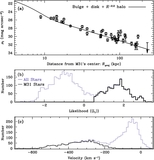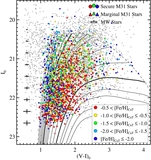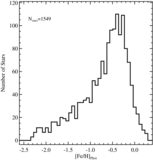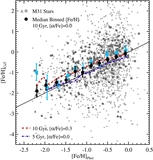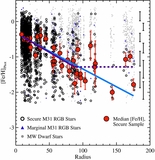Image Details

Caption: Figure 16.
Top: surface brightness vs. median metallicity of individual kinematic components in each of the M31 halo fields. Purple points denote measurements of stars belonging to the kinematically hot component in each field. The red stars and orange triangles are for individual kinematically cold components: red stars denote the values for lines of sight along the length of M31's Giant Southern Stream and its associated debris, while orange triangles are used for all other tidal debris features. Bottom: the surface brightness and metallicity of lines of sight in the Robertson et al. (2005) and Font et al. (2006a) simulations, color coded by the prominence of individual tidal streams along the line of sight. Lines of sight where the stellar population is dominated by one or two accretion events (stars and triangles in the top panel, pink contours in the bottom panel) are systematically more metal-rich at a given surface brightness than lines of sight with multiple progenitors contributing roughly equally to the stellar population (purple points in the top panel, blue contours in the bottom panel).
Copyright and Terms & Conditions
© 2014. The American Astronomical Society. All rights reserved.



